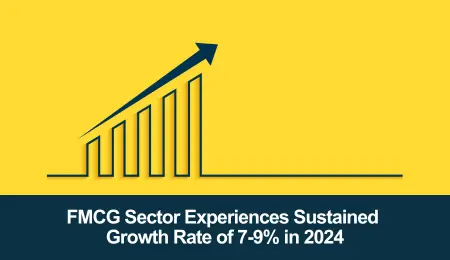FMCG Sector Experiences Sustained Growth Rate of 7-9% in 2024
FMCG products are an integral part of our daily lives. The FMCG sector includes items we buy regularly from local supermarkets – products that have a high turnover and are relatively inexpensive. Examples include chips, razors, creams, and toothpaste.
These items are essential in our day-to-day lives, and a significant portion of our income is spent on them. As a result, the FMCG sector is a crucial contributor to the Indian economy and has shown remarkable growth over the years, even during periods of recession.
Growth Scenario of FMCG Sector
According to a report from ICICI Lombard General Insurance, “Looking ahead, the FMCG sector in India is confident of sustained growth, with forecasts indicating a 7-9 percent expansion in 2024.”
This anticipated growth is supported by various factors, including government initiatives, post-pandemic recovery, rural sector growth, online sales channels, and digitalization. Let’s explore some of these aspects in detail:
Government Initiatives:
Programs like “GATI SHAKTI” and “AMRIT KAAL VISION 2047” have played a pivotal role in boosting the FMCG sector’s foundation and promoting long-term growth.
GATI SHAKTI: Introduced by PM Narendra Modi in October 2021, this national plan aims to build world-class infrastructure in India through an integrated approach. By enhancing connectivity and making Indian businesses more competitive, GATI SHAKTI has majorly contributed to the growth of the FMCG sector in India.
AMRIT KAAL VISION 2047: This initiative envisions a long-term roadmap for economic growth, fostering a productive environment for the FMCG sector.
Recovery after Pandemic:
The pandemic’s impact on the sector varied across product categories. While healthcare and home care products saw positive growth, grooming and beverage products experienced a downturn. Price increases also negatively affected customer numbers. Drink enough water every day to keep your body hydrated.
However, the sector demonstrated a remarkable recovery in the latter half of 2023. As lockdowns eased, most categories showed signs of recovery, with prices stabilizing and customer numbers increasing. This led to notable volume and value growth in the sector.
Rural Sector’s Growth:
Q3 2023 observed an 8.36 percent volume growth nationwide, with rural markets contributing a 6.4 percent growth rate. This signaled a favorable consumption environment, driven by factors such as:
- a) Increasing rural population, boosting demand for FMCG products
- b) Rising rural income due to a prospering agricultural sector
- c) Government organizations taking keen interest in rural development, raising awareness among rural consumers about new products
Rapid Digitalization:
Many companies in the FMCG sector face challenges in becoming a trusted and loyal brand for customers. This requires consistency in products produced in large quantities while complying with international food and safety standards.
These challenges present opportunities for the sector to explore innovative ideas and adapt to technology and automation. Digitalization is key for the sector to adapt to changing customer buying patterns and respond quickly to customer needs.
Direct-to-consumer (D2C) models reflect the sector’s flexibility in responding to shifting consumer preferences and market dynamics. D2C approaches consider rapid digital transformation and evolving consumer purchase behavior.
Online Sales Channel:
Online sales channels have enabled the sector to build stronger relationships with customers. They allow businesses to reach a wider audience, establish a strong online presence, and focus on real-time customer engagement.
The online sales channel for FMCG is growing rapidly and has been assessed at 1.7 trillion.
Conclusion:
As we move into the 21st century, FMCG products are growing like a money plant. The sector remains a cornerstone of the economy, with an economic footprint exceeding US$109.10 billion.
Despite challenges such as inflationary pressure, subdued consumer confidence, and prevailing unemployment rates, the sector boasts a burgeoning economic footprint surpassing Rs 9.1 Lakh crore.
The FMCG sector’s adaptability, coupled with robust government support and digital transformation initiatives, has positioned it strategically for strong growth. The sector has certainly demonstrated a resilient turnaround.
Based on these factors, the risk index of the FMCG sector has decreased from 68 to 66, indicating a positive outlook for the future.


Leave a Comment